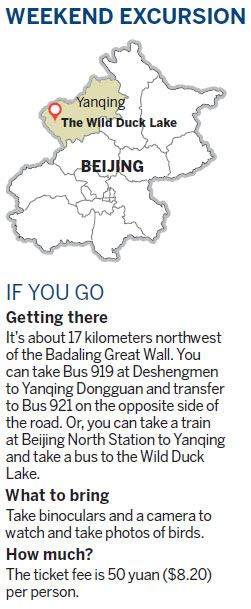

For bird-watchers, Wild Duck Lake in Yanqing county, Beijing is one of the best places to have an autumn outing for its various birds and plants, and steady wetland ecology.

The Wild Duck Lake National Wetland Park covers an area of 6,873 hectares, with 3,939 hectares of wetlands, making it the largest wetland natural protection area in Beijing. It has 280 species of birds, including 49 species of nationally protected animals.

It's about an hour and a half's drive from the downtown. The natural oxygen bar is a good place to watch birds, jog, cycle and go fishing, and you can come home with trophies of carps, catfishes and bigheads.
Your journey starts at the Wild Duck Lake Wetland Museum, where you will get to know everything about wetlands and the importance of protecting them. In the lobby, you will see a giant stone globe, which shows the distribution of wetlands in the world.
The exhibit of birds and plants specimens, photos, videos and visual projections show the natural scenery of the Wild Duck Lake wetland. The advanced technology of interactive projections makes you feel you're in the wetland, and you can see the birds and hear the water flow.
You may want to watch a documentary on the different sceneries of the lake throughout the year. It took two years to shoot the documentary, which depicts the migration and reproduction of various birds in the lake.
In addition to the beautiful scenery, the documentary also features precious clips of wildlife such as squabs breaking through their eggs.

You can have a bite of different fish from the lake at the park's canteen, such as fish head, fish soup, roasted fish, and braised fish in soy sauce. There are also local farm dishes including roasted potatoes, steamed pumpkins and handmade noodles. Or, you can have a delicious picnic in the abandoned wooden boats besides the lake.

You can rent a bicycle, tricycle or a tandem bicycle at the gate to cycle on the paths lined with golden ginkgo, to exercise and relax yourself a bit.
If you're lucky, you will see birds fly by and disappear into the reed marshes.
For bird-watchers, autumn is the best time to visit the lake. You will see different kinds of birds take perch or go foraging such as egrets, tufted ducks and wrens.
When you stroll on the wooden footpath on the lake, you will come across groups of wild ducks and several swans swimming leisurely.
You can feed them with bread or buy some bird food from the nearby shop.
The ducks will cluster around you and quack happily as you feed them bread crumbs.
In spring, you can see many wild ducks, wild gooses and swans swim in the lake to celebrate the end of the cold winter.
In summer, you can come to the lake to escape the heat, view pretty lotus flowers, and look for four-leave clovers in the vast clover fields.
The wetland is a winter home to many migrating birds including whooper swans and grey cranes.
These birds make the lake more lively and attractive.

When you go deep into the park, you will see a boundless stretch of reed marshes, which wave in the wind. You can climb to the three-floor wooden building to have a panorama view of the lake through the telescope.
Weather permitting, you can pitch a camp in the park, and chat with friends or read a book on the wooden desks, chairs and swings. The park is one of the several places in Beijing that has a campsite for campers, with supplies of water, electricity and guards.

Before you leave, you can buy a painting made of wild reeds, such as vivid flowers, birds and landscapes. It takes about a dozen procedures to finish the painting, ranging from cutting, pasting, carving, ironing to mounting.
xulin@chinadaily.com.cn
